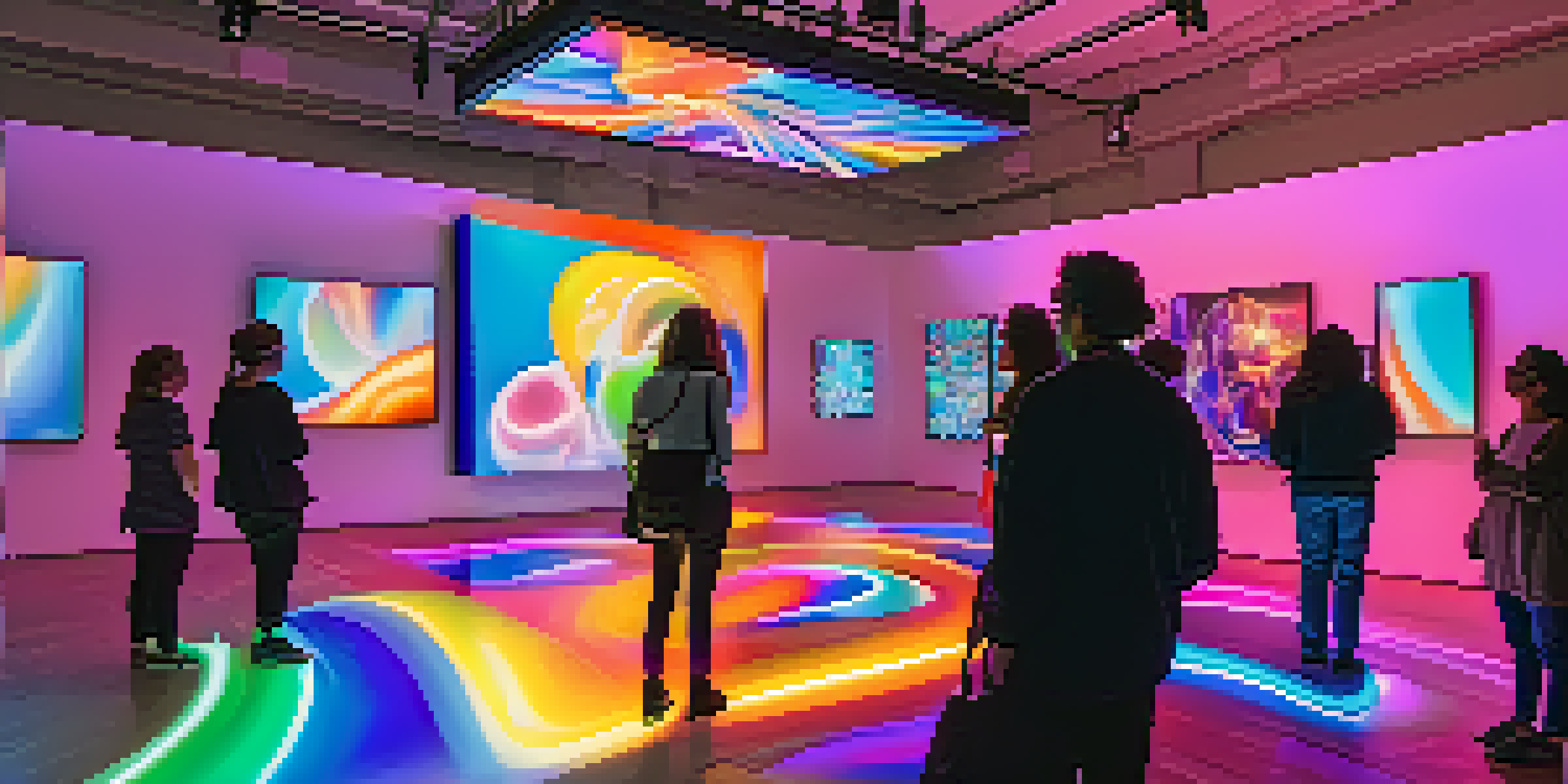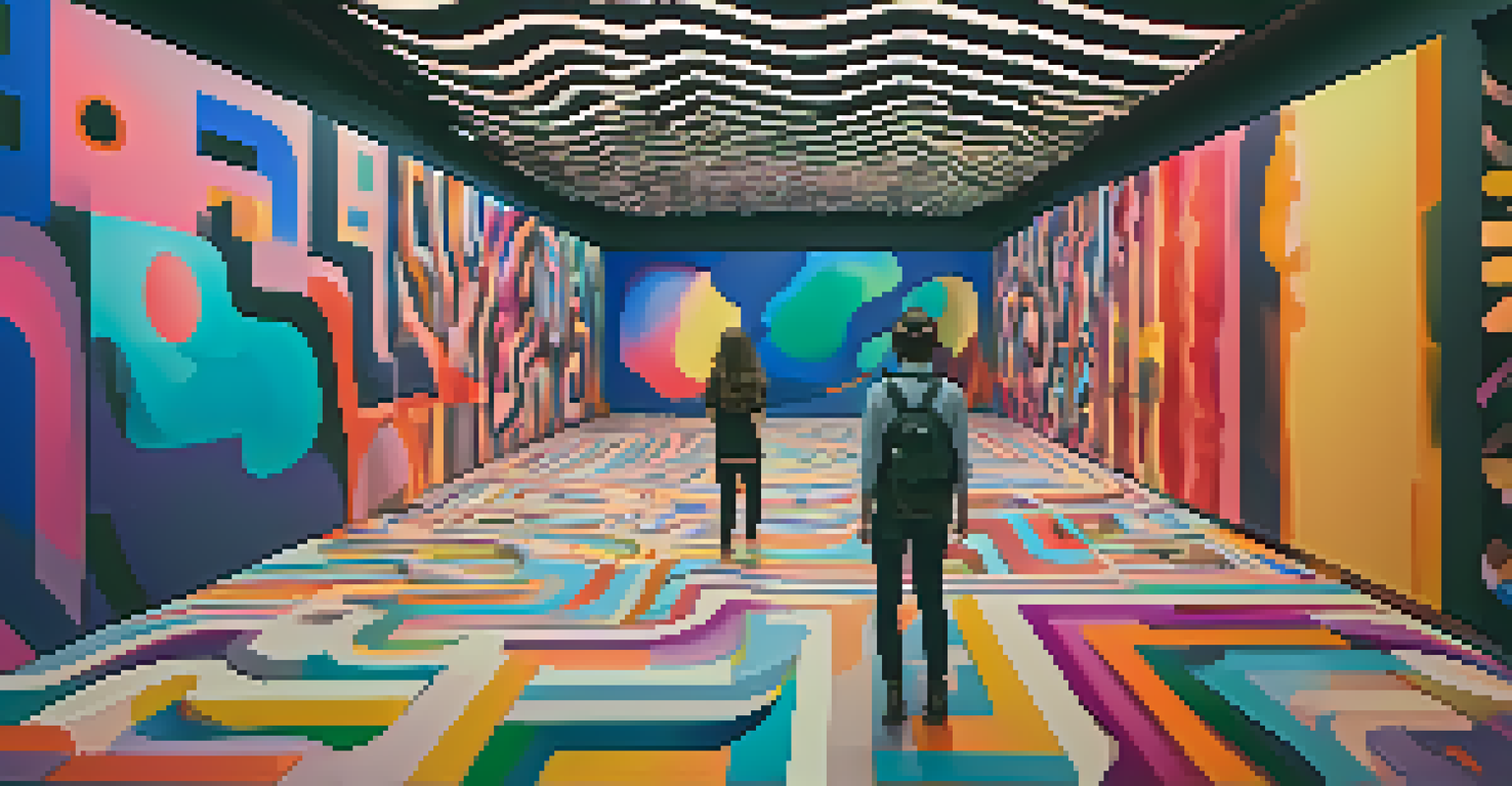The Influence of Video Games on Virtual Reality Art Creation

Understanding the Relationship Between Video Games and VR Art
Video games and virtual reality art share a unique bond, as both fields thrive on creativity and immersive experiences. At their core, video games create environments that allow players to explore and interact with art in ways that traditional mediums cannot. This interconnectedness has paved the way for artists to experiment with various techniques, blurring the lines between gaming and artistic expression.
Art is not a thing, it is a way.
As artists dive into the world of VR, they often draw inspiration from video game design principles, such as storytelling and user engagement. These elements encourage creators to think about how their art can evoke emotions and create memorable experiences. In this way, video games provide a rich source of inspiration for VR art, pushing artists to innovate and redefine their artistic boundaries.
Moreover, the evolution of technology in gaming has led to improved tools for artists, enabling them to bring their virtual creations to life. With advancements in graphics and interactivity, artists are empowered to create stunning visual landscapes that resonate with audiences. This synergy between video games and VR art is not just a trend; it signifies a profound shift in how we create and experience art.
The Role of Interactivity in Virtual Reality Art
One of the most striking aspects of virtual reality art is its interactivity, which is heavily influenced by video game mechanics. Unlike traditional art forms, VR art invites viewers to become participants, allowing them to engage with the artwork in a dynamic way. This interaction can evoke a sense of agency, making the experience more personal and memorable.

For instance, consider a VR installation where viewers can manipulate the environment, altering colors or shapes as they move through the space. This level of engagement mirrors the interactive nature of video games, where players control characters and influence outcomes. Such experiences challenge the conventional passive role of the viewer, transforming them into active contributors to the artistic narrative.
Interactivity Enhances VR Art
The incorporation of interactive elements from video games transforms viewers into active participants, enriching their engagement with virtual reality art.
As artists embrace these interactive elements, they are also compelled to think about user experience and design. The fusion of game design principles with artistic expression encourages a more thoughtful approach to creating immersive environments. This evolution not only enriches the art itself but also fosters a deeper connection between the artist and the audience.
Narrative Techniques Borrowed from Video Games
Video games are renowned for their storytelling capabilities, and this narrative focus has begun to influence virtual reality art creation. Artists are now exploring how to weave compelling stories into their VR experiences, drawing on the techniques used in gaming. This approach allows them to create multi-layered narratives that engage audiences on a deeper level.
The best way to predict the future is to create it.
For example, a VR art piece might guide viewers through a narrative journey, where each interaction reveals new layers of the story. This can create a sense of discovery similar to what players experience in a well-crafted video game. By incorporating narrative elements, artists can evoke emotions and provoke thought, transforming their work into something truly impactful.
Moreover, the blending of narrative and art opens up new avenues for collaboration between game designers and artists. This partnership can lead to innovative projects that push the boundaries of both fields, ultimately enriching the VR art landscape. As creators continue to experiment with storytelling, the line between gaming and art becomes increasingly blurred.
The Impact of Gamification on VR Art Experiences
Gamification, the application of game design elements in non-game contexts, has made its way into virtual reality art. By incorporating aspects like scoring systems, challenges, and rewards, artists can enhance the viewer's experience and encourage exploration. This not only makes the art more engaging but also fosters a sense of playfulness.
A VR installation that allows users to earn points for discovering hidden elements or completing challenges can lead to a more immersive experience. Just like in video games, this sense of achievement can motivate viewers to interact more deeply with the art, exploring every nook and cranny of the virtual environment. This playful approach transforms the way we perceive and interact with art.
Gamification Boosts Viewer Engagement
By applying game design elements like challenges and rewards, artists can create more immersive and playful VR experiences that encourage exploration.
Furthermore, gamification encourages artists to think creatively about how to engage their audience. By blending artistic expression with game mechanics, they can craft experiences that resonate on multiple levels. This innovative approach not only attracts a broader audience but also elevates the status of VR art within the larger artistic community.
Technological Advancements Shaping VR Art
The rapid advancement of technology in gaming has significantly impacted the creation of virtual reality art. Enhanced graphics, improved hardware, and the accessibility of development tools have opened doors for artists. These innovations allow creators to push the limits of their imagination, crafting stunning visual experiences that captivate audiences.
For instance, the introduction of powerful VR headsets and motion tracking technology has made it easier for artists to create immersive environments. This technology enables users to feel as if they are stepping into a painting or sculpture, experiencing art in a way that was previously unimaginable. As technology continues to evolve, so too will the possibilities for VR art creation.
Additionally, the integration of artificial intelligence in gaming is beginning to influence the artistic process. AI can assist artists in generating content, analyzing user interactions, and creating personalized experiences. This collaboration between technology and artistry is shaping the future of VR art, making it an exciting field for both creators and audiences.
Fostering Community Through VR Art and Gaming
Both video games and virtual reality art have a unique ability to foster community and connection among users. In gaming, players often come together to collaborate, compete, or share experiences, creating bonds that extend beyond the screen. Similarly, VR art installations can become communal experiences, inviting viewers to engage with one another and share their interpretations.
Imagine a virtual art gallery where visitors can interact with each other while exploring the artwork. This social aspect of VR art mirrors the multiplayer experiences found in video games, encouraging dialogue and collaboration. Such environments can lead to deeper discussions about the art and its meaning, enriching the overall experience.
Technology Fuels Artistic Innovation
Advancements in technology, including VR headsets and AI, empower artists to create captivating and personalized virtual experiences that redefine artistic expression.
Moreover, this sense of community can inspire artists to create more inclusive and relatable works. By considering the audience's perspective and encouraging interaction, artists can cultivate a shared experience that resonates with a diverse range of viewers. In this way, VR art not only showcases individual creativity but also builds connections between people.
Future Trends in VR Art Influenced by Gaming
As the relationship between video games and virtual reality art continues to evolve, we can expect to see exciting trends shaping the future of both fields. Artists are likely to explore even more innovative ways to incorporate gamification, storytelling, and interactivity into their work. This ongoing experimentation will push the boundaries of what VR art can achieve, ensuring it remains a dynamic and engaging medium.
Additionally, we may witness a rise in collaborative projects that blend gaming and art, bringing together developers, artists, and storytellers. This cross-disciplinary approach can lead to groundbreaking experiences that challenge traditional notions of both art and gaming. As these two worlds converge, the potential for creativity is limitless.

Ultimately, the influence of video games on virtual reality art creation is just beginning to unfold. As technology advances and artistic exploration continues, we can look forward to a future where immersive experiences captivate audiences in new and unexpected ways. The possibilities are as vast as the virtual landscapes artists are creating.